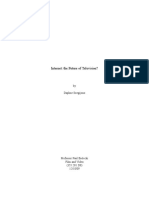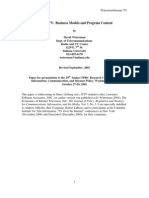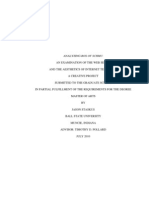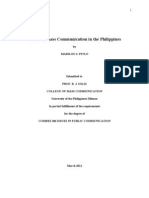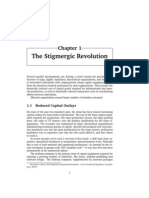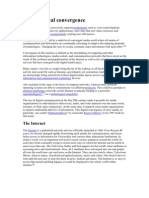TV? These Changing Economic and Cultural Logics of How Television Is Distributed and Consumed Over The
TV? These Changing Economic and Cultural Logics of How Television Is Distributed and Consumed Over The
Uploaded by
Saruba BaienCopyright:
Available Formats
TV? These Changing Economic and Cultural Logics of How Television Is Distributed and Consumed Over The
TV? These Changing Economic and Cultural Logics of How Television Is Distributed and Consumed Over The
Uploaded by
Saruba BaienOriginal Title
Copyright
Available Formats
Share this document
Did you find this document useful?
Is this content inappropriate?
Copyright:
Available Formats
TV? These Changing Economic and Cultural Logics of How Television Is Distributed and Consumed Over The
TV? These Changing Economic and Cultural Logics of How Television Is Distributed and Consumed Over The
Uploaded by
Saruba BaienCopyright:
Available Formats
International Journal of Communication 7 (2013), Book Review 17141717
19328036/2013BKR0009
Jose M. Alvarez-Monzoncillo, Watching the Internet: The Future of TV? Formalpress, 2011, 242 pp., $21.51 (paperback). Reviewed by Tim Dwyer University of Sydney
The
expectation
that
television
would
be
distributed
predominantly over the Internet rather than through the air has been mooted along with the rise of the Internet itself, and now the mobile Internet. Broadband infrastructures being rolled out around the world are premised on this assumption. The business reality of television is that Internet TV has emerged from the early 2000s as a competing delivery infrastructure to HD terrestrial, satellite, cable and mobile TV systems. Delivery systems include Internet protocol (IPTV) and videoon-demand (VoD) variants over managed network infrastructures. Available offerings depend on geographical location, but the betterknown streaming TV and film brands include Netflix, Hulu, Mubi, IndieFlix, Youku, Crackle, Fandor, and SnagFilms. Some brands, such as Current TV and Now TV, more clearly model traditional television scheduling practices; there are also hybrid players like Miro. Others, like the much-hyped Joost, now appear to be in a state of suspension, or no signal, only to be incessantly replaced by new startup platforms, such as Warner Archive Instant and Redbox Instant. There are a wide variety of subscription and payment mechanisms and strategies, in addition to content search tools. Many of the major broadcasters offer BBC iPlayer-style access mechanisms. Continuing widespread disintermediation of the value chain for traditional broadcast television (production-distribution-consumption) by the Internet has been a matter of when, not if, and this transition forms the basis of Jose M. Alvarez-Monzoncillos book, Watching the Internet: the future of TV? These changing economic and cultural logics of how television is distributed and consumed over the Internet are explored in an interesting blend that is part industry diagnostics (and prognostics) and part theoretical observation. The writing style itself is a stimulating mix of report empirics and analysis of media communications and cultural studies. The affordances of the Internet were always going to disrupt, indeed creatively destroy in a Schumpeterian sense, existing patterns of television access for audiences, related business models, and the regulation of Internet television. Alvarez-Monzoncillo argues that this dismantling of traditional modes of distribution has triggered profoundly utopian visions of the future of the television medium. (p. 10) Inherent in this transformation are new concepts of audiovisual entertainment in the tag era where users want to create, search, communicate, share, and distribute information and data (p. 10). In such folksonomy, Alvarez-Monzoncillo quite rightly asks is the tag the medium?(p. 166). However, he notes
Copyright 2013 (Tim Dwyer, timothy.dwyer@sydney.edu.au). Licensed under the Creative Commons Attribution Non-commercial No Derivatives (by-nc-nd). Available at http://ijoc.org.
International Journal of Communication 7 (2013), Book Review
Tim Dwyer 1715
the inevitable bias of the formulation, quoting G. H. Mead: the self emerges from the social process (p. 167). As a process that has been underway for more than a decade, television in its streaming IPTVVoD forms and institutional categories has been emergent in several guises: on portals that aggregate audiovisual content (both legally and illegally), user-generated content sites (YouTube, Vimeo), copyright infringing sites (e.g., in China and elsewhere), traditional media organization websites, video blogs and social networking sites, podcasts, and mobile devices such as smartphones and tablets. In relation to this diversity Alvarez-Monzoncillo makes the useful observation that the actual formats of much of this content (series, films, documentaries, and news programming) remains the same as when it was first distributed through more traditional channels. The book adopts a phases of television evolutionary approach that sees television evolving from the public and commercial analogue in the 20th century to the multichannel through to the personal phase of the 2000s and now to the period of long-tail content distribution and egocasting (p. 53). Alvarez-Monzoncillos predictions about the future of television are generally well informed in my opinion, and he eschews more conventional dystopian/utopian binaries. That said, some of his arguments skate close to a similar polarization. There is a nice collection of terms that intentionally invoke such binaries in Pyramids versus Ladders (Chapter 10), where the power and wisdom of collectivities, crowds, participation, and sharing are seen to have both light and dark sides. For example, much earlier in the book, he notes that on current trends as indicated in the net neutrality debate, two kinds of television may emerge. One that is very cheap, slow and riddled with adverts, and the other a fast network with high quality content (p. 18). The former will be open without payments while the latter will see subscriptionbased access. Furthermore, the free network will be based on P2P distribution while the pay-for-use network will have premium-level content that is gathered and stored on personal video recorders (PVRs). Other researchers have written about the evolution of the sociocultural, technological, and economic forms of Internet TV that Alvarez-Monzoncillo explores in Watching the Internet. For instance, Burgess and Greens book YouTube (Polity, 2009) is an important account of the wider impact Googles offspring have on media industries. The authors discuss how YouTube is enmeshed within the emerging media industries; and how it is being used by audiences and amateur producers to modify our ideas of cultural production and consumption. Audiences who want to create their own remix content (broadcast yourself as the slogan goes) in several genres (films, reviews, guides, apps) are referred to by Alvarez-Monzoncillo as a continuation of Negropontes 1980s idea of the return of the Sunday painter (p. 11). Yet individuals can now make small fortunes from their own channels on YouTube. Page views now are a serious advertising currency, and payments by Googles AdSense division mean that people are conjuring ways to make their content go viral. To take one example: a channel called Gregs Kitchen out of Brisbane, Australia, created a video called How to separate an egg white from a yolk. It is evidence of how this kind of video television model attracts vast (mass) audiences: in this case, in the order of 1.1 million page views. This generates significant advertising revenue. But monetization of the Internet is only one among many of the subthemes examined in Watching the Internet, so those interested only in business models and economics may be disappointed. Chapter 4, Financing the Internet and Television, may well satisfy this group of readers, however, and there is some interesting discussion of Internet
1716 Tim Dwyer
International Journal of Communication 7(2013), Book Review
advertising as the fastest-growing online sector (pp. 8990). Chapter 8 looks at low cost, premium, and freemium models. The discussion of advertising revenue and interactivity in Chapter 9 usefully makes reference to new mechanisms such as cost-per-thousand (CPM), cost-per-click (CPC), cost-per-action or acquisition (CPA), and cost-per-influence (CPI) (p. 147). Ive written about the various forms and business models of IPTV in my book Media Convergence (McGraw Hill/Open University Press, 2010). Like Alvarez-Monzoncillo, my argument was that the political economy of morphing media industries, together with changing habits and audience tastes, needs to be high up the list of determinative factors when we analyze the kinds of convergent TV businesses that emerge. So I agree with him when he says, it is a war between the multimedia convergence players (p. 195). Turner and Tay (Routledge, 2009) in their book Television Studies After TV: Understanding TV in the Post-broadcast Era have also examined these trends in the changing television industry. The strength of the contributions in their edited collection is an assumption of unevenness and divergent global practices, particularly outside the usual Anglophone nations that comparisons are often based on. It surveyed a range of convergent media now implicated in understanding how television is evolving. Watching the Internet makes some interesting contributions to these debates and usefully historicizes these developments too. However, at points in the book, I found myself looking for a more consistent and integrated theorization of the actual new modes of interacting with these popular Internet television brands, and how they vary in the way they engage with consumers. Consumption, after all, is the broader context in which these branded Internet TV offerings are operating. Alvarez-Monzoncillos discussion is concerned with television as a platform of consumption in several ways, but primarily as it is becoming increasingly individualized and personalized in both private and public contexts. Many of his arguments start around technological points, but these are then explicated in social and cultural terms, debunking myths along the way. For an alternative approach to a theorizing consumption, Pertierra and Turners recent book Locating Television: Zones of Consumption (Routledge, 2013) analyses traditional television as located within particular zones of consumption that shape the way that people are sutured into national, local, urban, rural, or geolinguistic zones. The authors persuasively make the case that television consumption is implicated in the construction of modernities. Alvarez-Monzoncillo also makes this argument, often in a fairly pessimistic way. For example, he argues, Mass television (broadcasting) has morphed into a segmented version (narrowcasting), as audiences are broken down into lifestyle groups and become uninterested in the rest of society (p. 198). This reminds me that the evolution of television is emblematic of that preeminent category of media studies being part of the consciousness industry, as Enzenberger and Roloff argued in their influential book The Consciousness Industry (Seabury, 1974). Pertierra and Turners book aims for an understanding of the sociocultural function of television in a number of national locations: the comparative dimension of their research (including an extensive focus on a Mexican case study) has directly informed the development of the notion of zones of consumption, as an alternative way of conceptualizing how media are located.
International Journal of Communication 7 (2013), Book Review
Tim Dwyer 1717
There are many excellent cutting-edge issues discussed in Watching the Internet, including socalled cloud television accessed via various mobile devices, and the implications of these practices for streaming and storage costs. Important risks like googlepoly, concentration of own ership, digital divides, and other diseases are highlighted. And in that context, the growing importance of regulation is recognized. The authors approach is levelheaded, and he is skeptical about overhyped promises and groupthink Internet progress myths. He brings critical awareness to his account of Internet television, and in the end displays a social realist view of change that involves audience taste cultures, society, the state, economics, and technology.
References Burgess, J., & Green, J. (2009) YouTube. Online video and participatory culture. Cambridge, UK: Polity. Dwyer, T. (2010) Media convergence. Maidenhead, Berkshire, UK: McGraw Hill/Open University Press. Enzenberger, H. M., & Roloff, M. (1974). The consciousness industry. On literature, politics and the media. New York, NY: Continuum/Seabury. Pertierra, A. C., & Turner, G. (2013). Locating television: Zones of consumption. New York, NY: Routledge. Turner, G., & Tay, T. (2009). Television studies after TV: Understanding TV in the post-broadcast Era. London, UK, and New York, NY: Routledge.
You might also like
- Generation Z's Screen Culture: Understanding Younger Users' Behaviour in The Television Streaming Age - The Case of Post-Crisis GreeceDocument19 pagesGeneration Z's Screen Culture: Understanding Younger Users' Behaviour in The Television Streaming Age - The Case of Post-Crisis GreeceIsabel MarquesNo ratings yet
- Examing The Specificity of TV Editing in Contemporary Crime DramaDocument38 pagesExaming The Specificity of TV Editing in Contemporary Crime DramaJonathan BerryNo ratings yet
- Video Screen Interfaces As New Sites of Media CircDocument24 pagesVideo Screen Interfaces As New Sites of Media CircFredericoNo ratings yet
- The Grammar of Hypertelevision - ScolariDocument23 pagesThe Grammar of Hypertelevision - ScolariAna Paula MargaridoNo ratings yet
- Going Over The Top: Online Television Distribution As Sociotechnical SystemDocument27 pagesGoing Over The Top: Online Television Distribution As Sociotechnical SystemJunior LopesNo ratings yet
- Home CastingDocument15 pagesHome CastingchrisNo ratings yet
- Television Device Ecologies Final Submitted Revised Version (1)Document20 pagesTelevision Device Ecologies Final Submitted Revised Version (1)karthikb7255No ratings yet
- Mass MediaDocument19 pagesMass MediaRoman DNo ratings yet
- Internet: The Future of Television?Document16 pagesInternet: The Future of Television?an0nymouzNo ratings yet
- Television Studies After TV-IntroDocument14 pagesTelevision Studies After TV-IntroQuang Nguyễn VănNo ratings yet
- Transmedia Audiences and Television Fiction: A Comparative Approach Between Skins (UK) andDocument17 pagesTransmedia Audiences and Television Fiction: A Comparative Approach Between Skins (UK) andWilhemina BrightsNo ratings yet
- Internet TV: Business Models and Program ContentDocument27 pagesInternet TV: Business Models and Program ContentDarrell RoathNo ratings yet
- Selling Television: Addressing Transformations in The International Distribution of Television ContentDocument6 pagesSelling Television: Addressing Transformations in The International Distribution of Television ContentLoredana CernatNo ratings yet
- Database DocumentaryDocument17 pagesDatabase DocumentaryRaluca CojocaruNo ratings yet
- Kim Jones Week Five PaperDocument6 pagesKim Jones Week Five PaperKim Lynch JonesNo ratings yet
- Mass_mediaDocument19 pagesMass_mediaNagraj NagrajNo ratings yet
- 1-3 Do Online Video Platforms - pdf2Document13 pages1-3 Do Online Video Platforms - pdf2fatimakanari92No ratings yet
- StaskusJ - Analyzing Box of SchmuDocument18 pagesStaskusJ - Analyzing Box of SchmudigitalstorytellingNo ratings yet
- Beyond Netflix and Amazon MUBI and The Curation of On-Demand FilmDocument17 pagesBeyond Netflix and Amazon MUBI and The Curation of On-Demand Filmemiliopbaca1202No ratings yet
- Mass MediaDocument24 pagesMass MediaSeher MalikNo ratings yet
- Mass Media Refers Collectively To All Media Technologies That Are Intended To Reach A Large AudienceDocument11 pagesMass Media Refers Collectively To All Media Technologies That Are Intended To Reach A Large AudienceSana0408No ratings yet
- Mass MediaDocument14 pagesMass MediaHameed Khan100% (4)
- Syllabus - PAPER 1 - Application of Computer in MediaDocument39 pagesSyllabus - PAPER 1 - Application of Computer in MediaAbubakar shomarNo ratings yet
- 1.1 & 1.2 Severin 2014 PDFDocument9 pages1.1 & 1.2 Severin 2014 PDFRohana MijanNo ratings yet
- The Future of Mass MediaDocument9 pagesThe Future of Mass MediaLouie SapalaranNo ratings yet
- DoyleDocument36 pagesDoylemoleculacursosNo ratings yet
- Emerging Dynamics in Audiences' Consumption of Trans-media Products: The Cases of Mad Men and Game of Thrones as a Comparative Study between Italy and New ZealandFrom EverandEmerging Dynamics in Audiences' Consumption of Trans-media Products: The Cases of Mad Men and Game of Thrones as a Comparative Study between Italy and New ZealandNo ratings yet
- Casado Guimerà BonetDocument18 pagesCasado Guimerà BonetMaria AdroverNo ratings yet
- Lesson 4Document2 pagesLesson 4Mark Russell MangubatNo ratings yet
- DRS, AprilDocument470 pagesDRS, Aprilfree.market.anticapitalist7523100% (1)
- Online Entertainment: A New Wave of Media Globalization?: Stuart CunninghamDocument17 pagesOnline Entertainment: A New Wave of Media Globalization?: Stuart Cunninghamyusuf kurniawanNo ratings yet
- Issues Mass MdeiaDocument6 pagesIssues Mass Mdeiapauline cunananNo ratings yet
- What Is Media ConvergenceDocument9 pagesWhat Is Media ConvergenceCold BlueNo ratings yet
- VAN ES, Karin. (2024) - Exploring Netflix Myths - Towards More Media Industry Studies and Empirical Research in Studying Video-On-DemandDocument16 pagesVAN ES, Karin. (2024) - Exploring Netflix Myths - Towards More Media Industry Studies and Empirical Research in Studying Video-On-DemandJunior LopesNo ratings yet
- Module 3. Writing For Television and RadioDocument35 pagesModule 3. Writing For Television and RadioFuentes Panerio RañelNo ratings yet
- Television Studies After TV-Part1Chapter1Document10 pagesTelevision Studies After TV-Part1Chapter1Quang Nguyễn VănNo ratings yet
- Audience Participation and The Evolution of Broadcast Models in The Brave New MediaDocument7 pagesAudience Participation and The Evolution of Broadcast Models in The Brave New MediaRobert AndrewsNo ratings yet
- Mediasphere. Mass Media Discourse: Olga Lavrentieva, 1 English GroupDocument29 pagesMediasphere. Mass Media Discourse: Olga Lavrentieva, 1 English GroupOlga LavrNo ratings yet
- 01 Chapter 001-025Document25 pages01 Chapter 001-025Steven EstradaNo ratings yet
- Technological ConvergenceDocument7 pagesTechnological Convergencesanthoshkumar213kNo ratings yet
- Empowerment Technologies PTDocument5 pagesEmpowerment Technologies PTPrince CarranzaNo ratings yet
- The Commodity Flow of U.S. Children'S Television: Matthew P. Mcallister & J. Matt GiglioDocument19 pagesThe Commodity Flow of U.S. Children'S Television: Matthew P. Mcallister & J. Matt GiglioAnaNo ratings yet
- Media Consumption: Mass Media Prevalence and FormsDocument6 pagesMedia Consumption: Mass Media Prevalence and FormsAmrinder SaharanNo ratings yet
- The Impact of New MediaDocument35 pagesThe Impact of New MediaHemanth Dot MajjiNo ratings yet
- Unsustainable Cinema: Global Supply ChainsDocument15 pagesUnsustainable Cinema: Global Supply ChainshumsaldanhaNo ratings yet
- Berton-How To Study The Complexity of Television (2021)Document18 pagesBerton-How To Study The Complexity of Television (2021)jbpicadoNo ratings yet
- Tele-Net: Media Convergence, Iview and The Future of Internet Broadcasting Virginia TappDocument7 pagesTele-Net: Media Convergence, Iview and The Future of Internet Broadcasting Virginia TappVirginia Eva TappNo ratings yet
- Telly FinalDocument18 pagesTelly Finalapi-326951827No ratings yet
- Platforms and DiversityDocument57 pagesPlatforms and Diversityhtngann19No ratings yet
- c3 Watchingworld ExecsummDocument5 pagesc3 Watchingworld ExecsummCélia GouveiaNo ratings yet
- Information, Communication & Society: To Cite This Article: Geoffrey Baym & Chirag Shah (2011) CIRCULATINGDocument24 pagesInformation, Communication & Society: To Cite This Article: Geoffrey Baym & Chirag Shah (2011) CIRCULATINGLander AspajoNo ratings yet
- LESSON 1 - For StudentsDocument2 pagesLESSON 1 - For Studentsdeborahapeh76No ratings yet
- Dual Portfolio Management Strategies of Online Subscription Video On Demand (SVOD) Companies: A Genre PerspectiveDocument23 pagesDual Portfolio Management Strategies of Online Subscription Video On Demand (SVOD) Companies: A Genre PerspectiveMutiara gunawanNo ratings yet
- Contemporary Screen Narratives Conference ReviewDocument5 pagesContemporary Screen Narratives Conference Reviewxwqj6dzrb5100% (3)
- Reader Report On Jostein Gripsrud-Emerging MediaDocument3 pagesReader Report On Jostein Gripsrud-Emerging MediaVeerla84No ratings yet
- 1864186Document31 pages1864186Carlos OrellanaNo ratings yet
- SampleChapter3 MassMediaDocument13 pagesSampleChapter3 MassMediagogirl23No ratings yet










